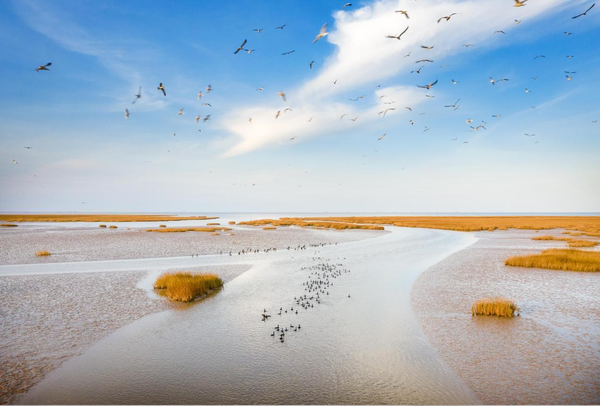By Li Rui, People's Daily
The Yellow River Delta National Nature Reserve, located at the river's estuary in east China's Shandong Province, has constantly enhanced its eco-compensation efforts in recent years, diverting nearly 360 million cubic meters of water from the river to the wetlands.
The nature reserve has effectively prevented saltwater intrusion from destroying the wetland ecosystem and alleviated the salinization of soils.
The Yellow River, China’s second largest river, flows into the Bohai Sea in Shandong’s Dongying. The deposition of huge amounts of sand and mud from the great river makes the Yellow River delta, which generates extensive wetlands.

The wetlands there, retreating from the sea, are extremely vulnerable. They once shrank in the 1980s and 1990s due to saltwater intrusion, coastal erosion, droughts and other factors.
To protect the wetland ecosystem and the rare birds living there, the Yellow River Delta National Nature Reserve was established in 1992. Covering 1,530 square kilometers, the nature reserve boasts the world's most complete and the youngest wetland ecosystem in warm temperate zone.
Sporobolus alterniflorus, commonly known as smooth cordgrass, hinders the stability of the wetland ecosystem, said Wang Jinhe, head of a Dongying institute that studies the development of the marine economy.
"The plant is very prolific and has a strong root system. It has severely encroached on the growing space of local plants such as Suaeda salsa and Chinese tamarisk. Its presence in the nature reserve had led to a sharp decline in the biological density of benthos in the tidal flat and reduction in the foraging and inhabiting space for birds. It is a threat against the biodiversity in the nature reserve," Wang explained.
Since 2016, Dongying, in collaboration with scientific institutions such as the Yantai Institute of Coastal Zone Research, Chinese Academy of Sciences, has used geographic information systems and remote sensing technology and launched field investigations to learn the distribution and intrusion mechanism of the smooth cordgrass in the Yellow River Delta.

As a result, it has developed multiple treatment technologies and carried out management projects that have effectively contained the expansion of the plant and restored the biotic population in the intertidal zone.
The nature reserve has also launched 16 wetland restoration projects with a total investment of nearly 1.08 billion yuan ($160.65 million), restoring 72,500 mu (4,833 hectares) of wetlands and flat from farmlands, connecting 241 kilometers of water channels, and recovering 47,000 mu (3,133 hectares) of Suaeda salsa and seagrass beds.
The unique restoration model has achieved remarkable progress that reaches long-term stability of natural succession with one treatment, and a compound ecosystem that includes river, land, flat and sea is taking shape. The integrity of the river estuary’s new wetland ecosystem is further enhanced.
Black-headed gulls, known as "elves on wetlands," are quite "picky" when choosing their breeding places, said Zhao Yajie, senior engineer of the Yellow River Delta National Nature Reserve's management committee, adding that the birds are an indicator of the ecological changes taking place on wetlands. The nature reserve has put the habitats of black-headed gulls, oriental white storks, cranes and other species under key protection, according to the engineer.

Over the years, the nature reserve has seen a prominent increase in the variety and number of bird species. Now, it is home to 371 bird species, up from 187 when it was just established.
Known as an "international airport for birds," the nature reserve has become an important stop, wintering ground and breeding place for birds migrating along the East Asia-Australasia and the West Pacific flyways. It is also an important breeding place for oriental white storks, the world's second-largest breeding place for black-headed gulls and the world's second-largest wintering ground for white cranes.
Dongying is currently working to build the Yellow River Estuary National Park, which will span 3,523 square kilometers, including 1,371 square kilometers of land area and 2,152 square kilometers of sea area. It will set a new sample for the protection of river and delta ecology as China’s first integrated land–sea national park.
"There must be more birds coming to and settling around the Yellow River estuary in the future," said Zhao.


